Leper colony
A leper colony, lazarette, leprosorium, or lazar house was historically a place to quarantine people with leprosy (Hansen's disease). The term lazaretto, which is derived from the biblical figure Saint Lazarus, can refer to quarantine sites, which were at some time also "colonies", or places where people affected by leprosy lived or were sent.[1] Many of the first lazarettes were operated by Christian monastic houses.[2] Leper hospitals exist throughout the world to treat those afflicted with leprosy, especially in Africa, Brazil, China and India.[2]

History
Leper colonies or houses became widespread in the Middle Ages, particularly in Europe and India, and often run by monastic orders. Historically, leprosy has been greatly feared because it causes visible disfigurement and disability, was incurable, and was commonly believed to be highly contagious. A leper colony administered by a Roman Catholic order was often called a lazar house, after Lazarus, the patron saint of people affected with leprosy.[3]
Some colonies were located on mountains or in remote locations in order to ensure quarantine, some on main roads, where donations would be made for their upkeep. Debate exists over the conditions found within historical colonies; while they are currently thought to have been grim and neglected places, there are some indications that life within a leper colony or house was no worse than the life of other, non-quarantined individuals. There is even doubt that the current definition of leprosy can be retrospectively applied to the Medieval condition. What was classified as leprosy then covers a wide range of skin conditions that would be classified as distinct afflictions today.[4]
Some leper colonies issued their own money (such as tokens), in the belief that allowing people affected by leprosy to handle regular money could spread the disease.[5][6]
In 1623 the Congregation of the Mission, a Catholic society of apostolic life founded by Vincent de Paul, was given possession of the Priory of St. Lazarus (formerly a lazar house) in Paris, due to which the entire Congregation gained the name of Lazarites or Lazarists - though most of its members had nothing to do with caring for lepers.
Political aspects

In 2001, government-run leper colonies in Japan came under judicial scrutiny, leading to the determination that the Japanese government had mistreated the patients, and the district court ordered Japan to pay compensation to former patients.[7] In 2002, a formal inquiry into these colonies was set up, and in March 2005, the policy was strongly denounced. "Japan's policy of absolute quarantine... did not have any scientific grounds."[8] The inquiry denounced not only the government and the doctors who were involved with the policy, but also the court that eatedly ruled in favor of the government when the policy was challenged, as well as the media, which failed to report the plight of the victims.
See also
- History of leprosy
- Kalawao, Hawaii
- Leprosy colony money
- Losheng Sanatorium
- Social distancing
References
- Doren, William Howard Van (1867). A suggestive commentary on the New Testament. p. 916.
The Ecclesiastical applications of the name, Knights of St. Lazarus, lazaretto, lazar-house, lazzarone are derived from the Lazarus of the parable. The Lazarists, a French Society of Missionary Priests, were named after Lazarus of Bethany.
- Encyclopedia of Pestilence, Pandemics, and Plaques, Joseph P. Byrne, 2008: Encyclopedia of Pestilence, Pandemics, and Plaques. Greenwood Publishing Group. 2008. p. 351.
- "Patron Saints Index: Saint Lazarus". Archived from the original on 2008-05-13.
- Archived October 23, 2008, at the Wayback Machine
- Unique experiment with currency notes(1970) Isaac Teoh, The Star, January–February, p7.
- The numismatic aspects of leprosy(1993), McFadden, RR, Grost J, Marr DF. p.21 D.C.McDonald Associates, Inc. U.S.A.
- "Koizumi apologises for leper colonies". BBC News. 2001-05-25. Retrieved 2007-03-20.
- "Japan's leprosy policy denounced". BBC News. 2005-03-02. Retrieved 2007-03-20.